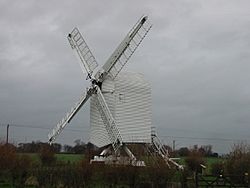Chillenden Windmill facts for kids
Quick facts for kids Chillenden windmill |
|
|---|---|
 |
|
| Origin | |
| Grid reference | TR 268 543 |
| Coordinates | 51°14′32″N 1°14′58″E / 51.24222°N 1.24944°E |
| Operator(s) | Kent County Council |
| Year built | 2005 |
| Information | |
| Purpose | Corn milling |
| Type | open trestle post mill |
| No. of sails | Four |
| Type of sails | Spring sails |
| Windshaft | Cast iron |
| Winding | Tailpole |
| No. of pairs of millstones | Two pairs located in the breast |
| Other information | Last post mill built in Kent. |
The Chillenden Windmill is a very special building. It's an open-trestle post mill located north of Chillenden, Kent, England. This means the whole top part of the mill can turn to face the wind. It's also a Grade II* listed site, which means it's an important historic place. This windmill is unique because it was the last post mill ever built in Kent.
Contents
A Look Back: The Mill's History
Building the Windmill
The Chillenden Windmill was built in 1868 by a company called Holman's from Canterbury. It replaced an older windmill that had been damaged in a strong wind. The builders even used some parts from the old mill to help construct the new one.
People have known about windmills in this exact spot for a very long time. They show up on old maps from as far back as 1596! This tells us that windmills have been an important part of the area for centuries.
Working Years and Repairs
Holman's, who were expert millwrights (people who build and repair mills), put in a new main beam and two new sails in 1927. The mill kept working, grinding grain, until 1949. Sadly, it lost one of its sails in a big storm that year.
In 1955, local people helped raise money to fix the mill and make sure it was protected from the weather. Then, on December 12, 1957, Kent County Council bought the mill for £100. They spent £728 to restore it, though some of its old machinery was taken out.
The Mill's Big Fall and Rebuilding
Why the Mill Collapsed
On November 26, 2003, something sad happened: the Chillenden Windmill collapsed. Experts figured out that one of the four main supports (called piers) had slowly sunk into the ground over time. Also, the mill was stuck in one position and couldn't turn to face the wind directly during the storm.
Bringing the Mill Back to Life
After the collapse, the broken pieces of the mill were carefully taken apart on December 15, 2003. They were stored away while people decided what to do next. There were ideas about moving it to a museum, but on March 31, 2004, Kent County Council announced that the mill would be rebuilt right where it stood.
IJP Millwrights, a company from Binfield Heath, Berkshire, did the amazing rebuilding work. They made new main beams, a new windshaft (the big axle that holds the sails), and rebuilt the front and back parts of the mill. They also put on new wooden siding all over. Four brand new sails were made to replace the ones that were on the mill when it fell. These new sails had actually been put on just a few years before, in 2001.
By early May 2005, the rebuilding started on site. The main frame of the mill was put back up on its new base on May 25, 2005. The newly rebuilt Chillenden Windmill was ready for visitors again on September 13, 2005. It was a huge effort to bring this historic building back!
How the Windmill Works
Inside the Mill
The Chillenden Windmill is a white open-trestle post mill. It has four spring sails that catch the wind. These sails are connected to a strong metal rod called a cast-iron windshaft.
The windshaft has a large gear wheel called a brake wheel. This brake wheel has fifty wooden teeth that turn another gear, called a wallower. The wallower is on a tall, upright metal shaft. At the bottom of this shaft is a big gear called a great spur wheel.
Grinding the Grain
The great spur wheel turns two pairs of millstones. These millstones are located in the front part of the mill. They work by grinding grain between them to make flour. The mill used to have a machine for crushing maize (corn), but this was removed during the restoration in 1958.
To make sure the mill faces the wind, it has a long wooden pole called a tailpole. Workers would use this tailpole to turn the entire top part of the mill so its sails could catch the most wind.
Millers Who Worked Here
- Haywood & Cage
- William Hopper Bean, from 1882 to 1899
- A Laker, in 1930
- N W Laker, in 1949
Images for kids
See also








